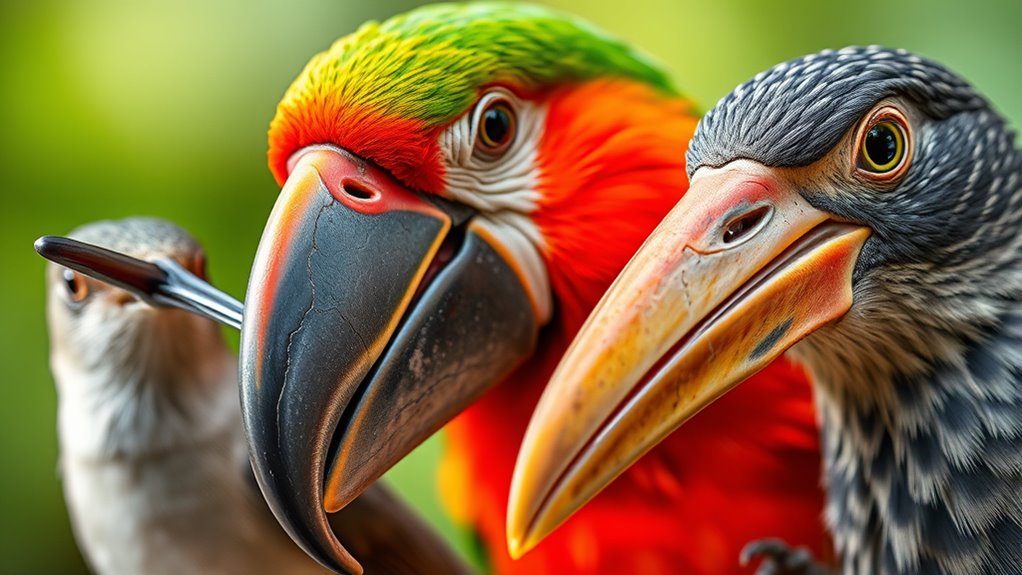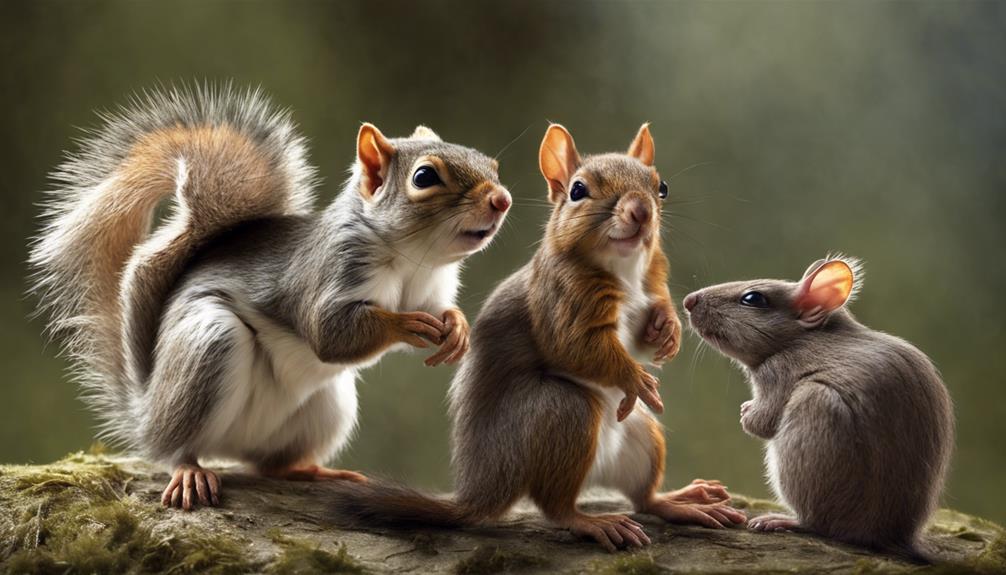The diversity of bird beaks showcases nature's incredible adaptability. Each beak type reflects specific dietary needs and environmental adaptations. For instance, woodpeckers use chiseling beaks to dig into wood, while hummingbirds possess long, slender beaks for accessing nectar. This variety is essential for survival in different habitats and plays a role in mating displays. Understanding these unique adaptations can reveal deeper insights into bird evolution and ecology, which you're about to discover more about.
Key Takeaways
- Bird beak diversity evolved after the Late Cretaceous mass extinction, adapting to various ecological niches and food sources.
- Beak morphology varies significantly, with shapes designed for specific feeding strategies and environmental needs.
- Specialized beaks, such as those of woodpeckers and hummingbirds, illustrate adaptations for unique habitats and diets.
- Beaks serve not only feeding purposes but also play roles in mating and territorial displays among bird species.
- Understanding beak diversity is essential for conservation efforts and maintaining bird populations in changing environments.
The Evolutionary Journey of Bird Beaks
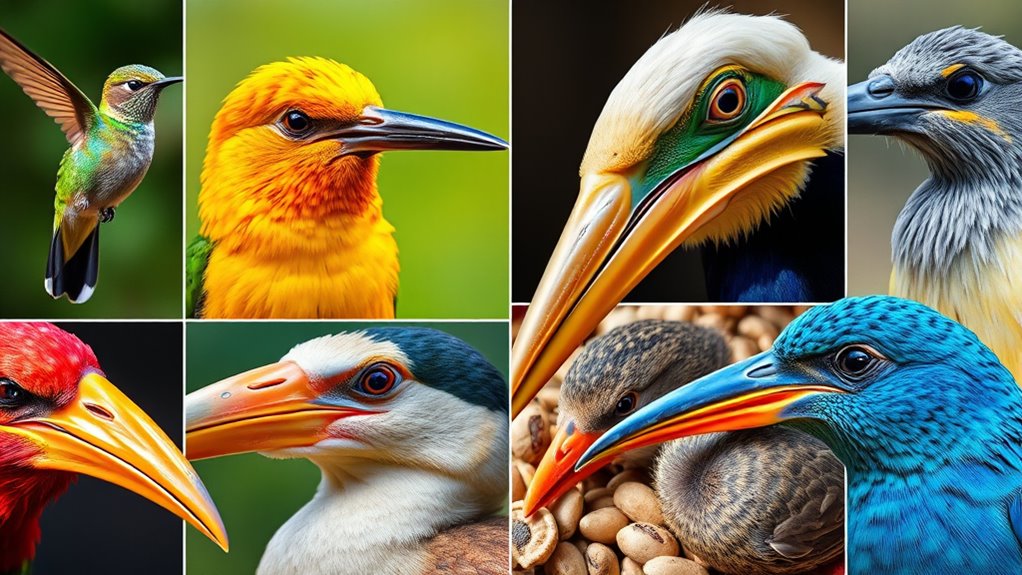
The evolutionary journey of bird beaks showcases a remarkable adaptability that emerged after the Late Cretaceous mass extinction event, which opened new ecological opportunities for birds.
Around 65 million years ago, beaks evolved rapidly, allowing different species to exploit various food sources. This initial diversification gave way to gradual refinement over the following millions of years.
As you observe modern birds, you'll notice how specialized beaks have developed to meet specific dietary needs and ecological roles.
Advances in 3D scanning technology have disclosed insights into over 8,700 species, revealing how environmental factors influence beak shapes.
Ultimately, this adaptive radiation highlights the incredible flexibility of developmental processes, leading to a stunning array of beak forms tailored to their unique habitats.
Beak Morphology and Its Functions
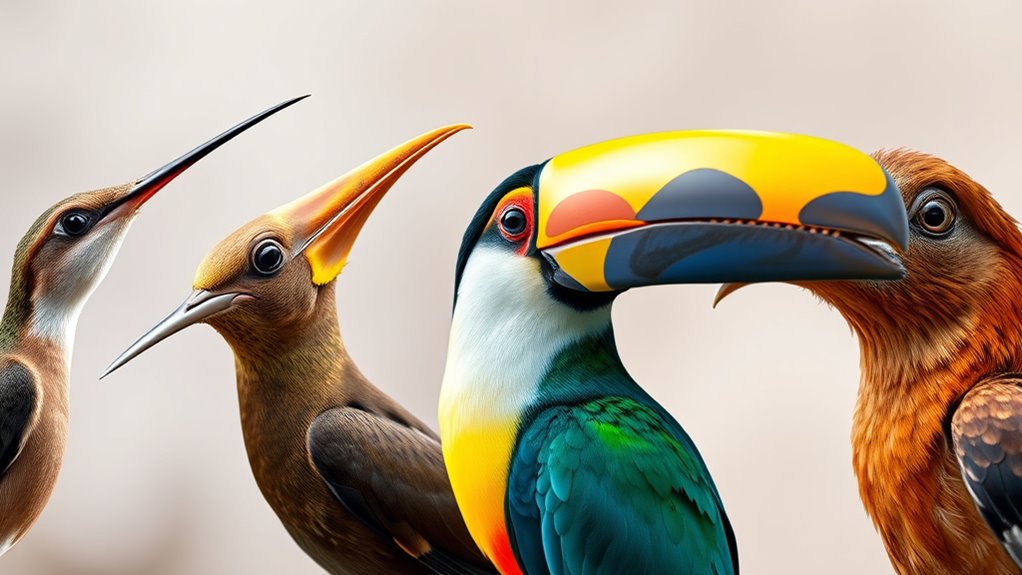
When you look at bird beaks, you'll notice a fascinating variety in their structure that directly relates to how birds adapt to their environments.
Each beak serves not just for feeding but also reflects the specific needs of the bird's lifestyle, from cracking seeds to probing for insects.
Understanding these functional adaptations reveals how closely linked beak morphology is to a bird's survival and success.
Beak Structure Variations
Bird beaks showcase a remarkable variety of structures, each uniquely adapted to meet specific dietary needs and environmental challenges.
The diversity in beak shape among bird species highlights their evolutionary paths. Here are three key variations:
- Length: The long-billed curlew boasts a beak that can exceed 8 inches, while tiny pine siskins possess beaks just over a third of an inch long.
- Functionality: Specialized adaptations, like the woodpecker's padded lower beak, enable effective foraging without injury.
- Multi-purpose: Some beaks serve as tools for crushing, tearing, or grabbing food, while also detecting taste and vibrations.
These beak structure variations reflect the intricate relationship between birds and their environments, showcasing nature's ingenuity in adaptation.
Functional Adaptations in Beaks
Exploring the diverse beak structures naturally leads to an understanding of their functional adaptations. Beaks in nature serve as specialized tools, with different shapes reflecting specific dietary needs.
For instance, the woodpecker uses its hammer-like beak to drill into wood, effectively absorbing shock to protect its brain. Hummingbirds have long, slender beaks that reach deep nectar, while the Sword-billed Hummingbird showcases extreme specialization with its elongated beak.
Additionally, some birds utilize their beaks not just for feeding but also as sensory organs, detecting taste and vibrations. The flexible pouch of the white pelican exemplifies how beaks can adapt for effective feeding strategies.
These functional adaptations highlight the incredible diversity among bird species.
Environmental Impact on Morphology
As environmental factors shape habitats, they greatly influence bird beak morphology, leading to diverse adaptations that enhance survival.
You can observe three key examples of how these adaptations manifest:
- The Sword-billed Hummingbird showcases an exceptionally long beak, allowing it to access nectar deep within flowers, a clear ecological adaptation to its floral environment.
- Woodpeckers possess specialized padded lower beaks, designed for drumming on wood, which helps prevent brain damage from impact during foraging.
- The Black-bellied Seedcracker shows variation in beak size that corresponds to available seed types in its habitat, highlighting how food availability drives evolutionary changes.
These adaptations guarantee that bird beaks effectively meet the demands posed by their environments, enhancing both survival and reproductive success.
Adaptations for Feeding: A Closer Look
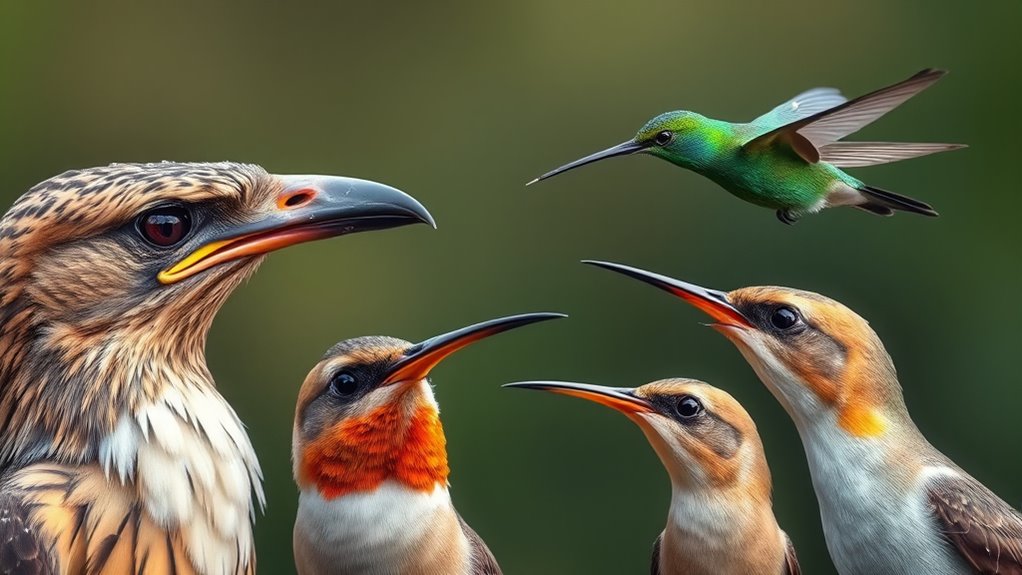
When you observe the various shapes of bird beaks, you'll notice how each one plays an essential role in their feeding strategies.
For instance, long beaks let hummingbirds sip nectar, while strong, thick beaks help seed-crackers crack tough seeds.
Understanding these adaptations reveals how birds efficiently access food in their unique environments.
Beak Shape Variations
Bird beaks showcase remarkable variations that reflect their adaptations for feeding. Each species has evolved distinct beak shapes to fit their dietary needs.
Consider these examples:
- Hummingbirds possess long, slender beaks to sip nectar from tubular flowers, showcasing their unique adaptations.
- Woodpeckers have specialized chiseling beaks for foraging insects in wood, while their padded lower beaks absorb shock during drumming.
- Black-bellied Seedcrackers demonstrate significant beak size variation, aligning with the types of seeds they consume, highlighting the relationship between beak shape and diet.
These adaptations illustrate how bird beaks are finely tuned to their feeding habits, ensuring survival in diverse environments.
Feeding Strategies Explained
Understanding how birds have adapted their feeding strategies reveals the intricate connection between beak design and dietary needs. Different bird specimens showcase remarkable adaptations tailored to their diets.
For example, hummingbirds have long, slender beaks perfect for sipping nectar from flowers, while Black Skimmers use their unique beaks to catch fish as they skim the water's surface.
Woodpeckers possess chiseling beaks, allowing them to drill into wood and uncover hidden insects. The Black-bellied Seedcracker illustrates how beak size varies among species, adapted to the seeds they consume.
Birds of prey, such as eagles and hawks, feature sharp, hooked beaks designed for tearing flesh, demonstrating their specialization for hunting.
Each bird's beak tells a story of survival and adaptation.
Specialized Beaks in Birds of Prey
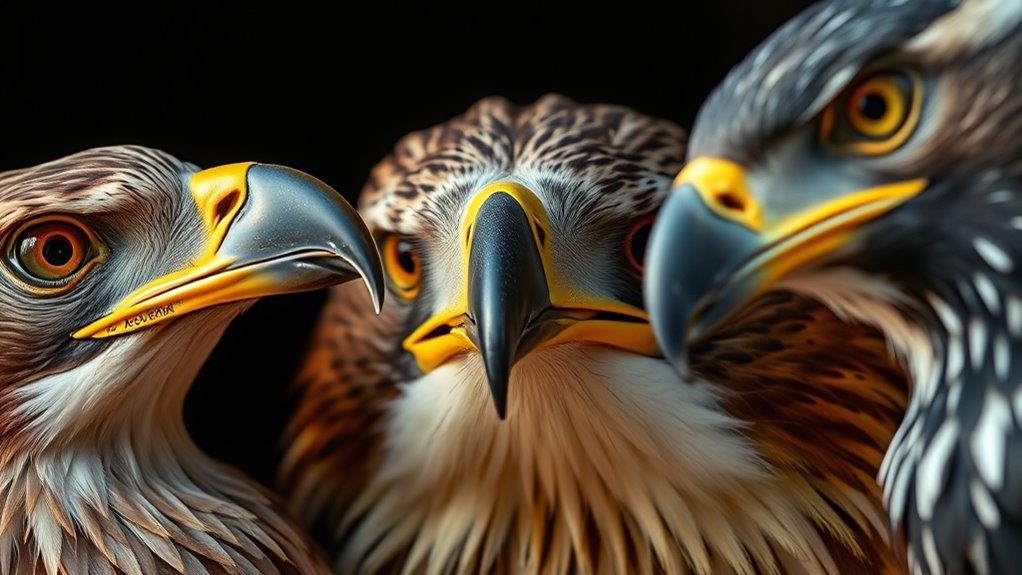
While many birds have beaks suited to their diets, birds of prey stand out with their specialized, sharp, hooked beaks designed for tearing flesh.
These adaptations are essential for their survival and predatory efficiency. Here are three key aspects of their beak morphology:
- Sharpness: The pointed edges help grip and shred their prey effectively.
- Hooked Shape: This design allows for better leverage when tearing meat from bones.
- Size: Larger beaks accommodate a wider range of prey, enhancing hunting success.
Take the Bald Eagle, for example; its beak is critical for catching fish.
With these adaptations, birds of prey showcase the evolutionary significance of specialized beaks in various environments, ensuring they remain effective hunters.
Conservation Challenges Facing Birds
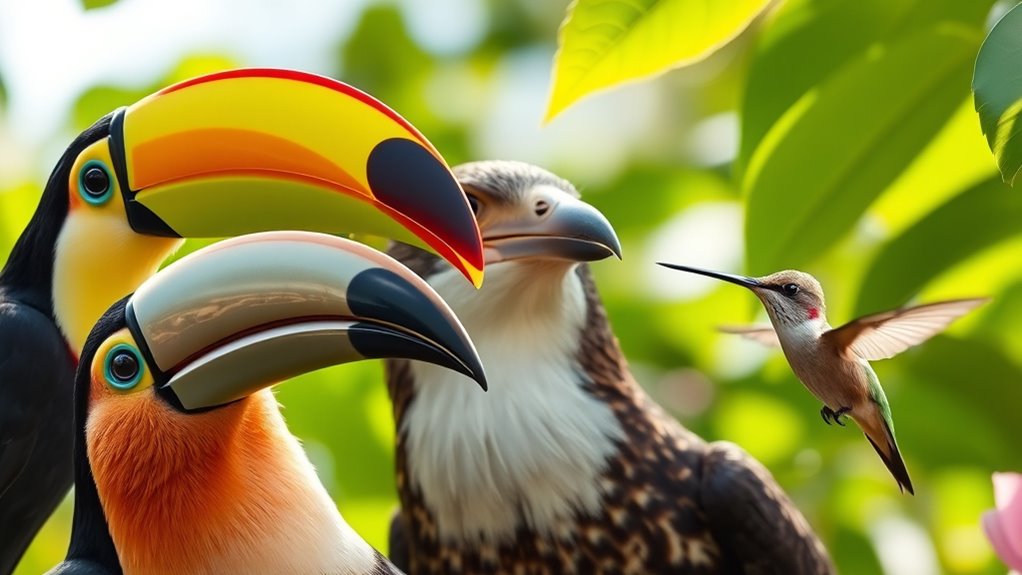
As we face a growing crisis in biodiversity, the challenges confronting bird populations are becoming increasingly urgent. Bird populations in the U.S. and Canada have declined by 2.9 billion breeding adults, primarily due to habitat loss. This loss not only impacts survival but also compromises food and shelter quality. Invasive species further threaten native birds by disrupting ecosystems. Additionally, collisions with structures and pesticide use greatly contribute to avian mortality.
| Challenge | Impact |
|---|---|
| Habitat Loss | Decreased food and shelter |
| Invasive Species | Disruption of ecosystems |
| Collisions | Major cause of mortality |
| Pesticides | Reduces food availability |
Addressing these conservation challenges is critical for protecting our feathered friends.
Community Engagement in Bird Research

Community engagement in bird research not only enhances scientific understanding but also fosters a sense of connection and stewardship among participants.
By getting involved, you can contribute to essential discoveries and support conservation efforts. Here are three ways you can participate:
- Join citizen science initiatives: Websites like "Mark My Bird" let you mark and categorize beak features, helping researchers analyze over 2,000 bird species.
- Participate in local programs: The Salem Audubon Society offers activities that promote birding and community involvement.
- Visit natural history museums: Engage with exhibits that highlight the diversity of bird beaks and learn how you can contribute to ongoing research, as half of the species remain unmarked, leaving room for discovery and exploration.
Frequently Asked Questions
What Were the Differences in the Bird's Beaks?
When you look at bird beaks, you'll notice they differ in size, shape, and function. Some beaks are built for crushing seeds, while others are perfect for tearing meat or sipping nectar from flowers.
You might find some beaks long and slender, while others are short and sturdy. These variations aren't just for looks; they're essential for how birds eat and interact with their environment, showcasing nature's incredible adaptability.
What Do the Beaks of Birds Vary With?
Birds' beaks vary with their diets, habitats, and evolutionary adaptations.
You'll notice that some beaks are designed for cracking seeds, while others are perfect for sipping nectar.
Environmental factors also play a role; different regions can lead to unique beak shapes that help birds access specific food sources.
Plus, the colors and sizes of beaks often reflect both functional needs and mating displays, showcasing the incredible diversity in avian life.
What Are the 4 Types of Bird Beaks?
Did you know there are over 10,000 bird species worldwide, each with unique adaptations?
When it comes to bird beaks, you'll find four main types: conical beaks for cracking seeds, hooked beaks for tearing flesh, flattened beaks for sifting through water, and long beaks for reaching nectar in flowers.
Each type reflects the bird's diet and foraging habits, showcasing nature's incredible adaptability in response to environmental needs.
What Are Some Examples of Diversity in Birds?
You'll notice that birds showcase incredible diversity in various ways.
For instance, consider the vibrant plumage of parrots, which can be a dazzling array of colors.
Then there are the unique behaviors of species like the migratory Arctic Tern, traveling thousands of miles each year.
Additionally, the size differences between a tiny hummingbird and a majestic ostrich highlight their adaptability to different environments.
Each example reflects nature's creativity and the birds' evolutionary journeys.
Conclusion
In exploring the fascinating diversity of bird beaks, you've seen how evolution shapes these remarkable tools for survival. Each beak tells a story, like a fingerprint of adaptation, revealing secrets of feeding and survival in diverse habitats. As you engage with these feathered wonders, remember that their future hangs in the balance, and your contributions can make a difference. By nurturing our connection with nature, you help protect these incredible creatures and their unique adaptations.
